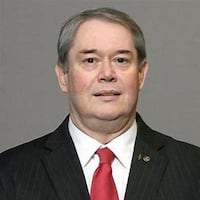Cpl. Clyde Anderson’s awards
Army Cpl. Clyde E. Anderson was the recipient of the Purple Heart, the Army Good Conduct Medal, the Army of Occupation Medal with Japan clasp, the World War II Victory Medal, the National Defense Service Medal, the Korean Service Medal with three bronze service stars, the Navy-Presidential Unit Citation, the Combat Medical Badge, the Honorable Service Lapel Button-World War II, the United Nations Service Medal, the Republic of Korea-Korean War Service Medal, and the Republic of Korea Presidential Unit Citation.
In addition, the primary next-of-kin is entitled to the Gold Star Lapel Pin as an appropriate identification for next-of-kin of members of the U.S. military who lost their lives while engaged in action against an enemy of the U.S.
Source: U.S. Army Human Resource Command, Fort Knox, Ky.
BLANCHESTER — The Korean War may be known as the “forgotten war” because it has technically never ended, but the remains of an Army corporal who had been missing for 62 years was remembered as he received a hero’s burial on Saturday.
While there were few mourners at the Littleton Funeral Home in Sabina, Army Cpl. Clyde Eugene Anderson, a short memorial service for the Hamilton native was conducted by Maj. Nick Chou, an Army chaplain, and the Patriot Guard Riders organization.
An Army dress blue uniform adorned with Anderson’s awards and ribbons could be seen in the casket. Sgt. 1st Class Robert Mitchell said Anderson’s remains were also in the casket, but were unseen.
In front of the casket was a photograph of Anderson and his bayonet that was sent by the Army to his sister Martha Benningfield, along with his other personal effects, according to Anderson’s niece Carol Snider. Snider, 63, said she was 1-year-old when Anderson went missing.
“This has been a great effort to see all of this happen,” she said.
A Navy reservist in the mid-1950s, Bill Stewart of Sabina never knew Anderson, but saw the funeral notice for Anderson and showed up for the visitation.
“I saw that he was here and that’s when I said that I was going to be there too,” he said. “I didn’t know the family but they got a lot of closure from this.”
In 1950, Anderson, then a 24-year-old private first class assigned to a medical company with 31st Regimental Combat Team, went missing in action on Nov. 28 when his convoy was ambushed by a vastly superior elements of the Chinese forces near the Chosin Reservoir.
His remains were among those commingled remains that were returned in 208 boxes that were returned by North Korea between 1990 and 1994. It is believed by the U.S. government that the remains of more than 400 service members were returned in those boxes.
After years of scientific research and testing, Anderson’s remains were identified and returned to his family from the Central Identification Laboratory in Honolulu. The remains were flown from Hawaii to Atlanta then to Dayton, and escorted by Sgt. 1st Class Adrian Robicheaux.
On Saturday, led by the Patriot Guard motorcyclists, the funeral procession went from Sabina, where people stopped to wave or place their hands over the hearts out of respect.
At the burial site, American Legion Post 179 in Blanchester was there with an honor guard along with a few dozen residents who came to observe the services. A volunteer honor guard from the Ohio Army National Guard carried the casket to Anderson’s final resting place as a bugler played “Taps” and a firing squad fired a rifle salute. The flag was presented to Snider, who was there with her brothers Bill and Dennis and their families. Also there was another cousin, Saundra Holland of Hamilton who lost touch with her family over the years.
Anderson is buried next to his sister.
“The people have given so much respect to him (Anderson),” Snider said. “There were so many people here it took my breath away. But I’m not stopping here because people need to know the job the Army is doing to identify these remains.”
About the Author
